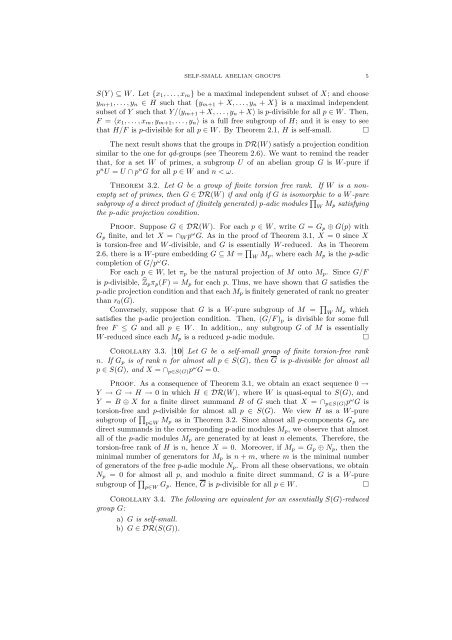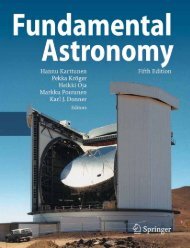Self-small Abelian Groups
Self-small Abelian Groups
Self-small Abelian Groups
You also want an ePaper? Increase the reach of your titles
YUMPU automatically turns print PDFs into web optimized ePapers that Google loves.
SELF-SMALL ABELIAN GROUPS 5<br />
S(Y ) ⊆ W . Let {x1, . . . , xm} be a maximal independent subset of X; and choose<br />
ym+1, . . . , yn ∈ H such that {ym+1 + X, . . . , yn + X} is a maximal independent<br />
subset of Y such that Y/〈ym+1 + X, . . . , yn + X〉 is p-divisible for all p ∈ W . Then,<br />
F = 〈x1, . . . , xm, ym+1, . . . , yn〉 is a full free subgroup of H; and it is easy to see<br />
that H/F is p-divisible for all p ∈ W . By Theorem 2.1, H is self-<strong>small</strong>. <br />
The next result shows that the groups in DR(W ) satisfy a projection condition<br />
similar to the one for qd-groups (see Theorem 2.6). We want to remind the reader<br />
that, for a set W of primes, a subgroup U of an abelian group G is W -pure if<br />
p n U = U ∩ p n G for all p ∈ W and n < ω.<br />
Theorem 3.2. Let G be a group of finite torsion free rank. If W is a nonempty<br />
set of primes, then G ∈ DR(W ) if and only if G is isomorphic to a W -pure<br />
subgroup of a direct product of (finitely generated) p-adic modules <br />
W Mp satisfying<br />
the p-adic projection condition.<br />
Proof. Suppose G ∈ DR(W ). For each p ∈ W , write G = Gp ⊕ G(p) with<br />
Gp finite, and let X = ∩W p ω G. As in the proof of Theorem 3.1, X = 0 since X<br />
is torsion-free and W -divisible, and G is essentially W -reduced. As in Theorem<br />
2.6, there is a W -pure embedding G ⊆ M = <br />
W Mp, where each Mp is the p-adic<br />
completion of G/p ω G.<br />
For each p ∈ W, let πp be the natural projection of M onto Mp. Since G/F<br />
is p-divisible, Zpπp(F ) = Mp for each p. Thus, we have shown that G satisfies the<br />
p-adic projection condition and that each Mp is finitely generated of rank no greater<br />
than r0(G).<br />
Conversely, suppose that G is a W -pure subgroup of M = <br />
W Mp which<br />
satisfies the p-adic projection condition. Then, (G/F )p is divisible for some full<br />
free F ≤ G and all p ∈ W . In addition,, any subgroup G of M is essentially<br />
W -reduced since each Mp is a reduced p-adic module. <br />
Corollary 3.3. [10] Let G be a self-<strong>small</strong> group of finite torsion-free rank<br />
n. If Gp is of rank n for almost all p ∈ S(G), then G is p-divisible for almost all<br />
p ∈ S(G), and X = ∩ p∈S(G)p ω G = 0.<br />
Proof. As a consequence of Theorem 3.1, we obtain an exact sequence 0 →<br />
Y → G → H → 0 in which H ∈ DR(W ), where W is quasi-equal to S(G), and<br />
Y = B ⊕ X for a finite direct summand B of G such that X = ∩ p∈S(G)p ω G is<br />
torsion-free and p-divisible for almost all p ∈ S(G). We view H as a W -pure<br />
subgroup of <br />
p∈W Mp as in Theorem 3.2. Since almost all p-components Gp are<br />
direct summands in the corresponding p-adic modules Mp, we observe that almost<br />
all of the p-adic modules Mp are generated by at least n elements. Therefore, the<br />
torsion-free rank of H is n, hence X = 0. Moreover, if Mp = Gp ⊕ Np, then the<br />
minimal number of generators for Mp is n + m, where m is the minimal number<br />
of generators of the free p-adic module Np. From all these observations, we obtain<br />
Np = 0 for almost all p, and modulo a finite direct summand, G is a W -pure<br />
subgroup of <br />
p∈W Gp. Hence, G is p-divisible for all p ∈ W . <br />
Corollary 3.4. The following are equivalent for an essentially S(G)-reduced<br />
group G:<br />
a) G is self-<strong>small</strong>.<br />
b) G ∈ DR(S(G)).
















